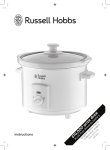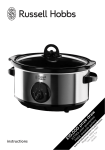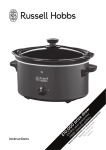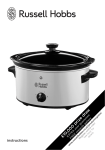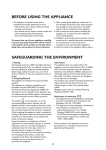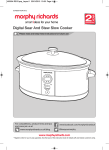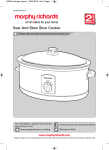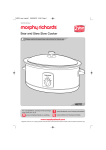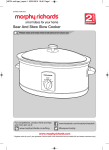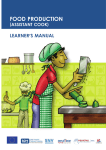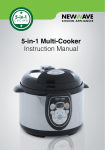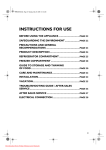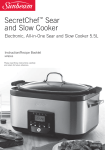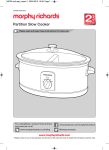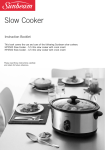Download Read The Instructions, Keep Them Safe. Pass
Transcript
instructions 2 Read the instructions, keep them safe. pass them on if you pass the slow cooker on. Remove all packaging, but keep it till you’re satisfied the cooker is working. important safeguards 1 The slow cooker must only be used by or under the supervision of a responsible adult. Use and store it out of reach of children. 2 Don’t put the slow cooker in liquid, don’t use it in a bathroom, near a source of water, or outdoors. 3Don’t cook on the low setting without first preheating the cookpot, in the slow cooker, on the high setting for at least 20 minutes. 4 Don’t cook on the warm setting – this setting must only be used to keep food warm after it has been cooked. 5Don’t use the slow cooker to re-heat food that has already been cooked. 6Dried beans (e.g. red kidney beans) must be boiled for at least 10 minutes before being added to the slow cooker. They’re poisonous if eaten raw or undercooked. 7 Don’t touch hot surfaces (including the outside of the slow cooker). Use the handles and lid knob, and wear oven gloves. 8Keep clear of steam issuing from the edge of the lid. 9Don’t touch internal surfaces till the slow cooker has cooled down fully. 10 Sit the slow cooker on a stable, level, heat-resistant surface. 11 Leave a clear space of at least 5cm (2 inches) all round it. 12 Route the cable so it doesn’t overhang, and can’t be caught or tripped over. 13 Unplug the slow cooker when not in use, before moving, and before cleaning. Let it cool down fully before cleaning or storing away. 14 Don’t try to cook in the slow cooker without using the cookpot. 15 Don’t cover the slow cooker or put anything on top of it while in use. 16 Don’t use the slow cooker near or below curtains or other combustible materials. 17 Keep the cable, the slow cooker, and the cookpot away from hotplates, hobs and burners. 18 Don’t put a hot cookpot on a cold surface, or in cold water, as it may crack. 19 Don’t put cold water into a hot cookpot, or hot water into a cold cookpot, as it may crack. 20Don’t use the cookpot with any appliance (cooker, hob, oven, microwave oven, etc.) other than the slow cooker. 21Don’t use accessories or attachments other than those we supply. 22Don’t use the slow cooker for any purpose other than that described in these instructions. 23Don’t connect the slow cooker to an external timer or remote control system. 24Don’t use the slow cooker if it’s damaged or malfunctions. 25If the cable is damaged, return the slow cooker, to avoid hazard. household use only 3 before using for the first time Remove all packaging and clean the slow cooker, to remove manufacturing dust, etc. the benefits of slow cooking health The gentle cooking action reduces damage to vitamins and retains more of the nutrients and flavours. economy Long, slow cooking can tenderise the cheaper, tougher cuts of meat, and uses about a quarter of the power of the small ring on the average hob. convenience Prepare the ingredients the night before, put them in the slow cooker in the morning, before you leave for work, and have a delicious meal waiting for you when you get home. the switch The slow cooker is controlled by a 4-position switch. the positions are: 0 off low for traditional “slow cooking”. You must preheat the cookpot, in the slow cooker, on high for at least 20 minutes before cooking at low. high for “fast cooking”, using the slow cooker as an electric stewpot. Keep an eye on it, to make sure that the food doesn’t dry out. If it looks like drying out, add hot water, not cold water – you might crack the cookpot. warm for keeping food warm – but only after it has been cooked to readiness in the slow cooker. caution Don’t use the warm setting to heat food up – you won’t kill the bugs. general 1 Thaw frozen food completely before adding it to the cookpot. 2 Brown the meat and sauté the vegetables in a pan, not in the cookpot. 3Don’t use the cookpot for cooking anywhere other than inside the slow cooker. 4 Don’t cook on the low setting without first preheating the cookpot, in the slow cooker, on the high setting for at least 20 minutes. 5Soak dried peas and beans for 8 hours (or overnight) before cooking, to soften them. warning boil dried beans (e.g. red kidney beans) for at least 10 minutes before adding to the slow cooker. They’re poisonous if eaten raw or undercooked. 6You don’t need to soak lentils overnight. 7 Store ingredients prepared beforehand (e.g. the night before) in containers in the fridge. Don’t put the slow cooker or the cookpot into the fridge. 8Root vegetables, tubers, and bulbs (carrots, potatoes, onions) take much longer to cook than meat, so cut them down to about 5mm (¼ inch) thick slices, sticks or dice, and sauté them gently for 2-3 minutes before adding to the cookpot. 9All vegetables (including dried veg) must be immersed in the cooking liquid. 10 When cooking with rice, use at least 150ml (¼pt) of cooking liquid for each 100g (4oz) of rice. We’ve found that “easy-cook” rice gives the best results. 11 Pasta isn’t suitable for slow cooking, it becomes too soft. If your recipe requires pasta, it should be stirred in 30-40 minutes before the end of the cooking time. 4 preparation 12 Decide when you want to eat and when you want to start cooking. 13 If you want to eat at 6 p.m., and you need to start cooking at 8 a.m., find a recipe that takes 8-10 hours. If you’re slow cooking at low power, an extra hour or so at the end of the cooking time doesn’t make much difference, as long as there’s sufficient cooking liquid to prevent the food drying out. 14 Prepare the food in accordance with the recipe. 15 Sit the slow cooker on a stable, level, heat-resistant surface. 16 Check that the slow cooker is off – turn the control to 0. 17 Plug the slow cooker into a wall socket (switch the socket on, if it’s switchable). 18 Put the cookpot into the slow cooker, and fit the lid. 19 Turn the control to high, and leave the slow cooker preheat for 20 minutes. 20Meantime, brown the meat and sauté the vegetables in a pan. 21Boil the cooking liquid in a pan. If you use a tinned cooking sauce, add it to the pan before bringing it to the boil. fill the cookpot 22When the 20 minutes is up, remove the lid (oven gloves) and put it on a heatproof surface. 23Put the meat and vegetables into the cookpot and add the boiling cooking liquid. choose the mode 24Turn the control to low for traditional slow cooking, or to high, if you’re using it as an electric stewpot. 25The light will come on, and cooking will start. finished? 26When the cooking time is over: a) if you want to serve the food right away, turn the control to 0, unplug the slow cooker (switch the socket off first, if it’s switchable) b) if you’re not ready to serve, turn the control to warm, to keep the food warm till you’re ready to serve serving 27Check that the slow cooker is off – turn the control to 0. 28Using oven gloves, remove the lid, and put it on a heatproof surface. 29It’s best to ladle the food from the slow cooker into serving dishes or plates. 30Don’t carry the slow cooker, the trailing cable may catch on something. 31You may use oven gloves to lift the cookpot, complete with the lid, but take care – if it’s full, it could weigh as much as 4kg (9lb). 32You’ll find that cleaning the cookpot is much easier if you remove all the food as soon as it’s cooked, then fill the cookpot with warm water. gravy/sauce Slow cooking retains more of the juices than normal cooking. This tends to increase the volume of cooking liquid, and thin the sauce or gravy. To allow for this, sauces should initially be thicker than normal. Anything to be sautéed could be tossed in seasoned flour beforehand, to thicken the gravy/sauce. 5 care and maintenance 1 Switch off (0), and unplug the slow cooker (switch the socket off first, if it’s switchable). 2 Using oven gloves, remove the lid and the cookpot and put them on a heatproof surface. 3If you don’t intend to wash up right away, fill the cookpot with warm water, otherwise residual heat may bake food debris on to the cookpot, making its eventual removal more difficult. 4 Don’t soak the exterior of the cookpot in water. The base is porous, so it may soak up water, which may then expand, and crack the cookpot when it’s heated. 5Wash the lid and cookpot in hot soapy water, using a cloth or sponge, then rinse and dry thoroughly. Don’t use scouring pads. 6All other surfaces, internal and external, should be wiped with a damp cloth. You may use a little washing-up liquid, if necessary. 7 Dry all surfaces thoroughly before re-using the slow cooker or storing it away. 8After some time in use, the glaze on the cookpot may develop “crazing”, a network of small cracks. This marking is superficial, and should not be a cause for concern. 9You may wash the cookpot and lid in a dishwasher, but we don’t recommend this. The harsh environment inside the dishwasher may affect the surface finishes. Any damage should be cosmetic, and should not affect the functionality of the cooker. 10 Don’t immerse the body of the slow cooker in water or any other liquid. 11 Don’t put the body of the slow cooker in a dishwasher. 12 Don’t use harsh or abrasive cleaners or solvents. a few recipes to start you off • Recommended cooking times and temperature settings are given after the title of each recipe – e.g. boeuf bourguignonne high 4-5/low7-8. This means you can cook it on high for anything from 4 to 5 hours, or on low for 7 to 8 hours. • Cooking for more than an hour or so over these times may affect the flavour. Nevertheless, if the recipe times don’t suit you, feel free to experiment. • The metric and imperial measures given in these recipes are not exact equivalents. Use either metric or imperial measures, don’t mix the two. • Use these recipes initially to familiarise yourself with the capabilities of your slow cooker. Then use them as a guide – vary the ingredients, vary the quantities, and taste the results. Keep notes, write down what changes you make, and you’ll build up a range of recipes which suit your taste. Keep notes of the not so successful ones too, so you know what not to do next time. • To adapt your own recipes for the slow cooker, we suggest you find a recipe in this booklet which uses similar ingredients, and use that as a guide for timing and liquid quantity, along with the food preparation guidelines given earlier. • Be careful with quantities. After all the ingredients are put into the cookpot, it shouldn’t be more than threequarters full, to allow for expansion. If you overfill, it may spit hot water, and it may overflow during use. 6 minestrone soup high 4-5/low 7-10 25g (1oz) butter 1 clove garlic, crushed 1 large leek, sliced 1 medium carrot, chopped small 1 medium potato, chopped 1 medium onion, chopped 1 celery stick, thinly sliced 100g (4oz) cabbage, finely shredded 397g (14oz) canned tomatoes including juice salt and pepper to taste 600ml (1pt) chicken stock 1 bay leaf 1 bouquet garni 25g (1oz) thin cut macaroni Heat the butter in a large pan. Add the garlic, leek, carrot, potato, onion and celery. Sauté till the butter is absorbed. Add the other ingredients, except the macaroni. Bring to the boil, transfer to the cookpot and cook for the time shown. 45 minutes before serving, remove the bay leaf and bouquet garni and add the macaroni. Adjust seasoning and serve with grated parmesan. Scotch broth high 7-9/low 10-14 175g (6oz) scrag end lamb, cut into pieces 500ml (1pt) water 25g (1oz) pearl barley 1 onion, sliced 100g (4oz) carrots, cut into small dice 100g (4oz) turnip, cut into small dice 1 leeks, thinly sliced chopped parsley to garnish salt and pepper to taste Put the lamb in a pan, cover with cold water and bring to the boil. Remove scum. Add the other ingredients, except the parsley. Bring to the boil, transfer to the cookpot, and cook for the time shown. Remove the bones, trim off any meat and return it to the broth. Adjust seasoning and sprinkle with parsley. French onion soup high 3-4/low 6-10 25g (1oz) butter or margarine 225g (8oz) onions, sliced 450ml (¾pt) chicken stock 1 bay leaf 4 slices French bread 75g (3oz) grated cheese salt and pepper to taste Melt the butter/margarine in a large pan and fry the onions till golden brown. Add stock, bay leaf and season to taste. Bring to the boil, transfer to the cookpot, and cook for the time shown. Remove the bay leaf. To serve: sprinkle slices of French bread with grated cheese and float on top of the soup. Remove the cookpot and brown under a hot grill till the cheese bubbles. Alternatively, toast the cheese on the bread and then float on top of the soup. old fashioned vegetable soup high 4-6/low 8-10 450g (1lb) mixed vegetables, chopped (potato, onion, carrot, celery etc.) 25g (1oz) butter 25g (1oz) flour 600ml (1pt) stock 5ml (1 tsp) mixed herbs salt and pepper to taste Melt the butter in a pan and fry the vegetables gently for 2-3 minutes. Stir in the flour and add the stock. Bring to the boil, season to taste and add mixed herbs. Transfer to the slow cooker. vegetables Slow cooking is ideal for vegetables. There’s little evaporation, so all the juices and flavours are retained. Oddly enough, root vegetables like potato, carrot, turnip, and swede, need more slow cooking than meat. Cut them into 5mm (¼”) slices, sticks or dice, and immerse in the cooking liquid. Cooking times vary with the type and age of the vegetables. Experience will soon show the best times for your own taste. Quickly cooked vegetables, like frozen peas and sweetcorn, must be thawed, then added half an hour before the end of cooking. Don’t slow cook baked potatoes in their jackets. 7 pulses (beans, peas and lentils) warning Boil dried beans (e.g. red kidney beans) for at least 10 minutes before adding to the cookpot. They’re poisonous if undercooked. Don’t soak lentils. Soak dried peas or beans overnight. Drain and rinse, then boil for 10 minutes, in the cooking liquid, before adding to the cookpot. Season at the end of cooking. For canned beans or peas, simply drain and add them 30 minutes before the end of the cooking time. ratatouille high 4-5/low 6-8 1 small aubergine, sliced 50g (2oz) butter 1 onion, chopped 1 clove garlic, crushed 1 green pepper, deseeded and diced 1 red pepper, deseeded and diced 397g can chopped tomatoes 2 courgettes, sliced salt and pepper to taste Slice the aubergine and sprinkle with salt. Leave for half an hour, rinse and pat dry. In a large pan melt the butter and fry the onion and garlic till transparent. Mix in the remaining ingredients, and cook for a further 2 minutes, stirring, then add to the cookpot. Cook for the time shown. stuffed tomatoes high 1-2/low 3-4 4 large, firm tomatoes 50g (2oz) fresh bread crumbs 50g (2oz) boiled ham, finely chopped 50g (2oz) cheese, grated salt and pepper to taste 5ml (1tsp) chopped parsley Cut a lid off the top of each tomato and scoop out the pulp. Mix the ham, cheese, breadcrumbs, seasoning, parsley, and a little of the tomato pulp to bind the mixture. Spoon into the tomatoes. Stand the tomatoes in the cookpot, add any extra filling and 15 ml (1tbsp) of water. vegetarian curry high 3-4/low 6-10 30ml (2tbsp) cooking oil 1 onion, chopped 1 clove garlic, crushed 2.5ml (½tsp) chilli 2.5ml (½tsp) turmeric 2.5ml (½tsp) coriander 2.5ml (½tsp) cumin 100g (4oz) lentils 600ml (1pt) white stock 5ml (1tsp) lemon juice salt and pepper to taste 1 carrot, diced 1 apple, peeled, cored and chopped 25g (1oz) sultanas Heat the oil in a pan. Lightly sauté the onion and garlic. Add the turmeric, chilli, coriander, cumin and lentils. Cook gently for a minute. Stir in the stock, lemon juice, salt and pepper. Bring to the boil and boil for 5 minutes. Transfer to the cookpot and stir in the carrots, apple and sultanas. fish Cooking fish in the cookpot develops delicate flavours slowly, retains the flavour and nutritive value, and holds the fish together. Don’t cook fish for long periods. 1Grease the base of the cookpot with butter or margarine. 2Clean, trim and wash the fish (rolled fillets and steaks are most suitable). Frozen fish should be completely thawed before slow cooking. Dry and place in the cookpot. 3Season well, sprinkle with lemon juice, then add hot stock, water or wine 4Dot some butter over the fish, and cook on low for 2-3 hours. poached cutlets of salmon low 2-3 2 x 175g-225g (6-8oz) salmon cutlets 150ml (¼pt) water 75ml (5tbsp) white wine 5ml (1tsp) salt 1 bay leaf 2 peppercorns 1 thin slice of onion 1 sprig parsley Put each cutlet on a piece of baking parchment and put into the cookpot. Put the other ingredients into a pan, bring to the boil, then pour over the salmon. Replace the lid and cook for the time shown. 8 Lift from the cookpot, then remove the parchment, bone and skin. Serve hot with melted butter or hollandaise sauce. To serve cold, transfer the salmon to a dish and pour over the cooking liquid. When cold, drain and serve with salad or coat with aspic made from the liquid. stuffed mackerel low 2-4 2 medium size mackerel 1 large tomato, skinned and chopped 20ml (4tsp) lemon juice 1 cooking apple, peeled, cored and chopped 1 slice of bread, crumbled chopped parsley to taste Gut and clean the mackerel. Remove the head, bones and fins. Leave the tails. Lay the mackerel out, skin side down, season and sprinkle with lemon juice. Mix the other ingredients, and spread thickly over the mackerel. Roll up from head to tail, and secure with a cocktail stick or thread. Butter baking parchment and the bottom of the cookpot, put the parchment in the cookpot and the fish on the parchment. Cook for the time shown. Portuguese haddock low 2-3 25g (1oz) butter ½ medium or 1 small onion, very thinly sliced 2 haddock or cod steaks or fillets 1 bay leaf 298g (10½oz) can condensed cream of tomato soup salt and pepper to taste Butter the bottom of the cookpot. Lay the onion on the butter, then the fish and bay leaf. Season. Boil the tomato soup in a pan, stirring well, and pour over the fish. Cook for the time shown. Remove the bay leaf before serving. boiled ham high 4-5 1.8kg (4lb) gammon joint Put the gammon in a pan and cover with cold water. Bring to the boil, drain and rinse. Stand in slow cooker and cover with boiling water. Cook for the recommended time. Drain and allow to cool slightly before removing skin. Wrap tightly in kitchen foil. Put into refrigerator till well chilled. Coat fat with toasted bread crumbs before serving. pâté Use the cookpot as a water bath to provide the gentle even temperature necessary for cooking. chicken liver pâté high 3-5/low 8-10 4 rashers streaky bacon 450g (1lb) chicken livers 1 medium onion, sliced 2 cloves 2 bay leaves 1 bouquet garni 5ml (1tsp) salt 50g (2oz) butter 50g (2oz) flour 150ml (¼pt) milk 1 clove garlic, crushed 30ml (2tbsp) cream 1, size 2 egg salt and black pepper to taste Use a 16cm (6”) round cake tin or small loaf tin. Butter the inside and line the bottom with bacon rashers. Put the liver, onion, cloves, bay leaf, bouquet garni and salt in a pan, and add water to cover. Bring to the boil and cook for a few minutes till the liver stiffens. Cool. Remove the cloves, bay leaf and bouquet garni. Blend the liver, onion and about 30ml (2tbsp) of the cooking water for about a minute, or till smooth. Alternatively, chop finely with a sharp knife. Melt the butter in a pan and stir in the flour. Gradually add the milk and cook till thick. Add liver, garlic, cream and egg. Season to taste with black pepper and salt. Turn into the cake tin and cover with foil. Put the cake tin into the cookpot and pour boiling water round it. Cook for the time shown. The pâté should be firm to touch. Let it cool in the tin. Chill before serving. 9 meat Slow cooking tenderises cheaper cuts, and reduces shrinkage and evaporation, retaining flavour and nutritive value. The size and shape of the joint, its quality, and the proportion of lean, fat and bone, all affect cooking times. When testing a dish to see if it’s cooked, don’t forget that root vegetables usually take longer to cook. Thaw frozen meat completely before cooking. Recipe times are given only as a guide. Where a different cut of meat is used cooking times may need to be adjusted. Avoid meat with a high proportion of fat, or trim the excess fat. Joints up to 1.6kg (3½lb) can be cooked, depending on shape and fit. The meat mustn’t force the lid up. 1Season the meat, then brown on all sides in a frying pan. 2Transfer to the cookpot and cook on high for the time shown. 3Pork joints with rind may be grilled for 10 minutes to crisp. 4If possible, turn joints once during cooking, to ensure even tenderness. joint weight setting time beef, lamb, pork 1-1.6kg (2-3½lb) high 5-7 hours beef and vegetable casserole with dumplings high 4-6/low 7-10 450g (1lb) stewing beef (shin/shoulder/chuck) 25g (1oz) flour 30ml (2 tbsp) cooking oil 1 large onion, sliced 550ml (1pt) beef stock 2 carrots, thinly sliced salt and pepper to taste Cut the meat in cubes and toss in seasoned flour. Heat the oil in a pan and brown the meat. Transfer to the cookpot. Fry the onions lightly in the pan. Stir in the remaining flour, gradually add the stock and carrots. Bring to the boil, then transfer to the cookpot, and cook. dumplings high 45 minutes 50g (2oz) self-raising flour 2.5ml (½tsp) salt 25g (1oz) shredded suet 30ml (2tbsp) chopped parsley 45ml (3tbsp) cold water Make the dumplings by mixing flour, salt, suet and parsley. Add water and mix to a soft dough. Shape into 8 balls. Add to the casserole and cook on high for 45 minutes with the lid on. Irish stew high 6-8/low 9-14 2 carrots, thinly sliced 1 onion, thinly sliced 225g (8oz) potatoes, thinly sliced 5 neck of lamb chops 450ml (¾pt) chicken stock 2 bay leaves salt and pepper to taste Put the vegetables into the cookpot. Trim the chops of excess fat and lay on top. Add the seasoning, bay leaf and boiling stock. Cook for the time shown. braised liver and onions high 2-4/low 5-7 30ml (2tbsp) cooking oil 225g (½lb) lambs liver, thinly sliced 25g (1oz) plain flour 1 large onion, thinly sliced 300ml (½pt) beef stock Heat the oil in a frypan. Coat the liver in the flour and fry till sealed. Transfer to the slow cooker. Add the onions to the pan and fry till golden. Stir in the remaining flour and stock. Bring to the boil, stirring. Pour over the liver and cook for the time shown. Serve with grilled bacon. bolognese sauce 15ml (1tbsp) cooking oil 1 clove garlic, crushed 396g (14oz) can chopped tomatoes + juice 150ml - 300ml (¼ -½pt) beef stock 10ml (2tsp) dried basil 1 bouquet garni high 3-4/low 6-10 1 onion, finely chopped 450g (1Ib) minced beef 140g (5oz) can tomato purée 75g (3oz) button mushrooms, sliced 1 bay leaf 30ml (2tbsp) dried mixed peppers 10 Heat the oil in a pan, and fry the onion and garlic lightly. Add the beef, and fry till brown. Stir in the other ingredients. Bring to the boil, transfer to the cookpot, and cook for the time shown. Remove the bay leaf and bouquet garni. Serve with spaghetti or noodles, and grated parmesan. lasagne low 4-6 100g (4oz) lasagne 25g (1oz) butter 1 medium onion, chopped finely 1 large clove garlic, crushed 400g (1lb) mince 2 tsp oregano salt and freshly ground black pepper 2 tbsp tomato purée or paste cheese sauce 15g (½oz) butter 15g (½oz) flour 150ml (¼pt) milk 75g (3oz) grated cheese parmesan cheese for topping salt and pepper to taste Grease the cookpot. Boil the lasagne in lightly salted water for 4-5 minutes. Dry on paper towels. Heat the butter in a pan and fry the onion and garlic till transparent. Add the mince and oregano and fry for 3-4 minutes, stirring. Season with salt and pepper and add the tomato purée. To make the cheese sauce, heat the butter in a pan and stir in the flour. Gradually stir in the milk. Bring slowly to the boil, still stirring. Season with salt and pepper and add the cheese. Layer the mince, pasta, and cheese sauce in the cookpot, finishing with a layer of cheese sauce. Sprinkle parmesan on top and cook on low for 4-6 hours. braised brisket of beef high 6-8 1.5kg (3lb) brisket salt and pepper to taste 25g (1oz) butter 1 large onion, chopped 1 large carrot, finely chopped 300ml (½pt) beef stock 1 bay leaf flour or cornflour to thicken Season the meat. Heat the butter in a pan and brown the meat. Transfer to the slow cooker. Fry the onions and carrot till the onion is transparent. Add stock and bay leaf and bring to the boil. Pour round the meat. Cook for the time shown. Remove the meat to a serving dish. Keep hot. Strain the stock. In a pan, blend a little flour with cold water to make a paste. Gradually add the stock. Bring to the boil, stirring. Adjust the seasoning. Serve the gravy with the meat. savoury pork casserole high 3-4/low 6-10 30ml (2tbsp) cooking oil 500g (1Ib) lean pork, cut into cubes 1 large onion, sliced 30ml (2tbsp) flour 300ml (½pt) white wine 150ml (¼pt) chicken stock 60ml (4 tbsp) tomato purée 1 green pepper, deseeded and chopped 150g (6oz) button mushrooms salt and pepper to taste 5ml (1tsp) dried sage 3 large tomatoes, skinned and sliced Heat the oil In a large pan and lightly brown the pork. Add the onions. Stir in the flour and add the wine, stock and tomato purée. Add the green peppers and mushrooms. Bring to the boil, season and add sage and tomatoes. Transfer to the cookpot and cook for the time shown. boeuf bourguignonne high 4-6/low 7-10 15ml (1tbsp) cooking oil 500g (1lb) stewing steak, cubed 50g (2oz) streaky bacon, chopped 15ml (1tbsp) flour 150ml (¼pt) red wine 15ml (1tbsp) brandy 150ml (¼pt) stock good pinch thyme 1 bay leaf 1 clove garlic, crushed 6-8 shallots or tiny onions, whole salt and pepper to taste Heat the oil in a pan and lightly brown the beef and bacon. Add the flour, and stir in the wine and brandy. Add the other ingredients and season. Bring to the boil, transfer to the cookpot, and cook for the time shown. Remove the bay leaf before serving. 11 pork and pineapple curry high 3-4/low 6-8 500g (1lb) lean pork (cut into cubes) 25g (1oz) flour 5ml (1tsp) salt 30ml (2tbsp) cooking oil 1 large onion, chopped 15ml (1tbsp) curry powder 15ml (1tbsp) paprika pepper 300ml (½pt) chicken stock 1 dried red chillies 15ml (1tbsp) mango chutney 5ml (1tsp) worcester sauce 454g (1lb) can pineapple cubes + juice 2 bay leaves Toss the pork in the flour and salt. In a large pan heat the oil and brown the meat. Lift out on to a plate with a draining spoon. In the same pan, fry the onions till soft. Stir in the curry powder and paprika pepper. Fry for 2 minutes then return meat to the pan. Stir well and cook for a few minutes. Add remaining ingredients, bring to the boil and transfer to slow cooker. Cook for the recommended time. Remove bay leaves before serving. boiled bacon in apple juice high 4-5 collar of bacon 1kg (2lb) apple juice 550ml (1pt) onion, sliced 1 small cornflour 30ml (2 tbsp) freshly ground black pepper to taste Put the bacon in a large pan, cover with cold water, and bring to the boil. Put the bacon in the cookpot, and discard the water. Put the apple juice and onion in the pan, bring to the boil, and pour over the bacon. Add pepper. Cook for the time shown. Remove the bacon to a serving dish, and keep hot. Put the cornflour in a small pan and blend with a little cold water. Gradually stir in the apple juice. Bring to the boil and simmer for 2 minutes. Serve with the bacon. poultry Use poultry up to 1.5 kg (3lb). The lid mustn’t be raised by the meat. Thaw frozen poultry before cooking. Cook whole poultry unstuffed, on high. 1Wash and dry the poultry and season inside and out. 2Brown the skin in its own fat or a little cooking oil, in a large frying pan. 3Transfer to the cookpot and cook on high for the time shown. poultry weight setting time chicken 1.5 kg (3lb) high 3½-4 hours pheasant large high 3-4 hours chicken with barbecue sauce high 4½ -5 40g (1½oz) butter whole 1kg (2lb) chicken 1 medium onion, finely chopped 60ml (4tbsp) tomato ketchup 30ml (2tbsp) vinegar 30ml (2tbsp) mango chutney, chopped 2.5ml (½tsp) French mustard 5ml (1tsp) caster sugar 15ml (1tbsp) worcestershire sauce salt and pepper to taste Rub inside the cookpot with a little of the butter. Wipe the chicken and season inside and out. Heat the remaining butter in a large pan and brown the chicken all over. Transfer to the cookpot. Put the onion in the pan and fry for 2-3 minutes, without colouring. Add the other ingredients and bring to the boil. Pour over the chicken and cook for the time shown, basting occasionally. country chicken casserole high 5-7/low 8-10 4 chicken joints, skinned 397g (14oz) can tomatoes, including juice 198g (7oz) can sweet corn, drained 2 sticks celery, finely chopped 1 medium onion, finely chopped 50g (2oz) white cabbage, finely shredded 1 bay leaf 5ml (1tsp) mixed herbs 300ml (½pt) chicken stock, boiling salt and freshly ground black pepper to taste Put all the ingredients into the cookpot making sure that the fresh vegetables are covered by the boiling hot stock. Cook for the time shown. 12 duck á l’orange high 5 -5½ hours + 1 hour 1 clove garlic, crushed 3 duck portions 15g (½oz) butter 2 onions 75g (3oz) button mushrooms, thinly sliced 25g (1oz) flour 300ml (½pt) orange juice Heat a large pan and fry the duck joints on all sides in their own fat till well browned. Transfer to the cookpot. Without adding fat, cook for the time shown. Drain the fat and discard. Heat the butter and fry the onions and mushrooms till soft. Add the flour and slowly stir in the orange juice. Pour over the duck in the cookpot and cook for a further hour on high. chinese chicken and mushroom high 3½ -5/low 8-10 15ml (1tbsp) cooking oil 4 chicken joints 1 onion, roughly chopped 30ml (2tbsp) cornflour 150ml (¼pt) chicken stock 225g (8oz) button mushrooms, halved 30ml (2tbsp) soy sauce juice of 1 lemon 5ml (1tsp) sugar salt and pepper to taste Heat the oil in a large pan and fry the chicken till golden brown. Transfer to the cookpot. In the remaining oil, fry the onion till transparent, stir in the cornflour, then gradually stir in the stock. Add the other ingredients, bring to the boil, pour over the chicken, and cook for the time shown. coq au vin high 3½ -5/low 8-10 15ml (1 tbsp) cooking oil 4 chicken joints, skinned 50g (2oz) flour 100g (4oz) streaky bacon, chopped 1 large onion, chopped 300ml (½pt) chicken stock 300ml (½pt) red wine 100g (4oz) button mushrooms, sliced 1 bay leaf 2 cloves 1 bouquet garni salt and pepper to taste Heat the oil in a pan. Coat the chicken in seasoned flour and brown all over. Transfer to the cookpot. Put the bacon and onion in the pan and soften but don’t brown. Stir in the remaining flour and add the other ingredients. Bring to the boil, stirring, and pour over the chicken. Cook for the time shown. Remove the bay leaf, cloves and bouquet garni before serving. puddings To poach fruit, follow the methods for pears in red wine or rhubarb and orange. If you want a topping on poached fruit, use an ovenproof bowl. Don’t put the cookpot in an oven. Egg custards cook gently, with little risk of overcooking or curdling. Steamed puddings won’t fill the kitchen with steam, or need constant topping up. Use a heatproof pudding basin, which fits the cookpot without touching the sides. Make a lifting strap to lower the pudding basin into the cookpot. Fold a 45cm (18”) long piece of aluminium cooking foil till it’s about 5cm (2”) wide. Stand the basin on the strap and lower into the cookpot. Leave in place during cooking and use it to remove the hot basin. Half fill the cookpot with water. When cooking steamed puddings or those containing a raising agent, pre-heat the cookpot for 20 minutes and cook on high for the time shown. baked stuffed apples high 2-3/low 4-6 15g (½ oz) butter 100g (4oz) soft brown sugar 50g (2oz) sultanas 3 medium cooking apples, cored 150ml (¼pt) boiling water Grease the cookpot with the butter. Core the apples. Use a sharp knife to score the skin round the equator on each apple. Mix the sugar and sultanas and pack tightly inside the apples. Stand each apple on a square of foil shaped to form a saucer. Arrange the apples and foil in the cookpot and pour in the boiling water. Cook for the time shown. The cooking time for this recipe may vary with different types of apples. 13 zesty orange pudding high 5-7/low 8-10 1 small orange, peeled and sliced 50g (2oz) soft margarine 50g (2oz) caster sugar 1, size 3 egg, beaten 75g (3oz) self-raising flour pinch salt 1 orange, grated zest and juice 25g (1oz) sultanas Butter a 550ml (1pt) basin and line the base with a buttered circle of foil. Put one orange slice on the base and arrange the others around the sides Cream the margarine and sugar till light and fluffy. Beat in the egg a little at a time. Fold in the sieved flour and salt. Add the orange zest and sufficient juice to form a soft dropping consistency. Fold in the sultanas and turn into the prepared basin. Cover loosely with foil. Using the lifting strap lower the basin into the slow cooker. Pour enough boiling water into cookpot to come half way up the basin. Cook for the time shown. pears in red wine high 3-5/low 6-8 75g (3oz) sugar 400ml (¾pt) red wine rind and juice of 2 lemons 2 cloves 4 medium ripe pears 1-2 drops cochineal Put the sugar, wine, lemon rind, juice and cloves in a pan. Heat gently, stir till the sugar dissolves, then take off the heat and add the cochineal. Peel the pears leaving them whole, complete with stalks. Stand them in the cookpot, stalks upwards, and pour over the syrup. Cook for the time shown, turning the pears occasionally, so they’re evenly coated with the syrup and colour evenly. Remove the cloves, and serve hot or chilled with cream. creamy rice pudding high 4-4½/low 5-7 15g (½oz) butter 400ml (¾pt) milk 150ml (¼pt) evaporated milk 50g (2oz) pudding Rice 25g (1oz) sugar Butter the inside of the cookpot. Add all the ingredients and stir. Cook for the time shown. rhubarb and orange high 2-2½/low 3-4 500g (1lb) rhubarb 75g (3oz) sugar grated rind and juice of 1 medium orange 300ml (½pt) water Wash the rhubarb and cut into 2.5cm (1”) pieces. Put the ingredients into the cookpot and cook for the time shown. poached dried fruit salad high 3-4/low 5-7 450g (1lb) mixed dried fruit (prunes, apricots, pears, apples etc) 100g (4oz) sugar (or according to taste) juice of 2 lemons or oranges 700ml (1¼pt) water Put the fruit and water in the cookpot and soak overnight. If the apple slices float to the surface, weigh them down with prunes. Next day, add the other ingredients and cook for the time shown. Serve hot or chilled. Christmas pudding 25g (1oz) self-raising flour 2.5ml (½tsp) nutmeg 50g (2oz) shredded suet rind and juice of half a lemon 25g (1oz) blanched almonds, chopped 50g (2oz) currants 25g (1oz) mixed peel 15ml (1tbsp) black treacle 100ml (7tbsp) stout or ale high 13/reheat - high 5 2.5ml (½tsp) cinnamon 2.5ml (½tsp) mixed spice 50g (2oz) fresh white bread crumbs 25g (1oz) soft brown sugar 50g (2oz) seedless raisins 50g (2oz) sultanas 25g (1oz) prunes, stoned and chopped 30ml (2tbsp) rum 1 large egg 14 Sieve together the flour and spices. Add the suet, breadcrumbs, lemon rind, sugar, nuts and dried fruit. Warm the treacle in a pan till it becomes runny. Add the rum, stout and lemon juice. Pour over the eggs and mix together. Add to the dry ingredients. Mix thoroughly, cover and stand overnight. Add a little milk if the mixture has stiffened. Pre-heat the cookpot for 20 minutes. Turn the mixture into a buttered 1 litre (2pt) pudding basin. Select a basin which comfortably fits in the cookpot without raising the lid. Cover with foil. Stand in the cookpot and add enough boiling water to come two thirds of the way up the sides of the basin. Cook for the time shown. Allow to become cold. Remove foil and cover with greaseproof paper and fresh foil. Christmas pudding is the only dish which can be reheated safely in the slow cooker. It’s at its best if left to mature for a while between cooking to make, and cooking to eat. To reheat, cook on high for about 5 hours. brandy and orange punch high 1-2/low 3-5 150g (5oz) sugar 300ml (½pt) boiling water 6 cloves 5ml (1tsp) cinnamon zest and juice of 1 lemon juice of 1 orange 1 orange, sliced 30ml (2tbsp) orange squash ¼ bottle white wine 150ml (¼pt) brandy Put the sugar and boiling water into the cookpot. Stir in the other ingredients except the brandy. Heat for the time shown. Stir in the brandy just before serving. lemon curd high 2½-3/low 4-6 50g (2oz) butter zest and juice of 2 lemons 225g (8oz) caster sugar 2 eggs, size 3 Melt the butter in a pan. Add the lemon juice, rind and sugar, and stir till dissolved. Allow to cool. Beat the eggs lightly and stir into the mixture. Pour into a 1 litre (2pt) basin. Cover with foil. Stand the basin in the cookpot. Pour enough boiling water into the cookpot to come half way up the basin. Cook for the time shown or till thickened. Stir thoroughly, pour into warmed pots and allow to cool. Store in a cold place for no longer than 2 weeks. cheese fondue low 1 hour 40 minutes 1 clove garlic, cut in half 300ml (½pt) dry white wine 225g (8oz) gruyere cheese, grated 225g (8oz) emmenthal cheese, grated 20ml (4tsp) cornflour pepper to taste grated nutmeg to taste Rub the inside of the cookpot with garlic. Add the wine and cook for 40 minutes on low. Mix the cheese with the cornflour and seasonings. Stir this mixture into the wine. Cook for 1½ hours, stirring after 30 minutes. The fondue may now be left in the cookpot. To serve, spear cubes of crusty bread with forks and dip in the fondue. apple chutney high 3-5/low 8-9 750g (1¾lb) apples, peeled & finely chopped 225g (8oz) onions, finely chopped 350g (12oz) light brown sugar 100g (4oz) sultanas 150ml (¼pt) white wine vinegar 30ml (2 tbsp) cornflour 10ml (2 tsp) salt 1 clove garlic, crushed pinch cayenne pepper 2.5ml (½ tsp) ground cinnamon 2.5ml (½ tsp) ground ginger Put the apples, onions, brown sugar and sultanas into the slow cooker. Mix the cornflour and vinegar together in a small bowl till completely smooth. Add the cornflour/vinegar mix to the slow cooker with the salt, garlic, cayenne pepper, cinnamon and ginger. Stir well. Cook for the time shown. Pour into heated jars and cover in the usual way. Alternatively, store in a container in the refrigerator for up to 2 weeks. 15 connection The product must be earthed. It has a 13A BS1362 fuse in a 13A BS1363 plug. To replace the plug, fit the green/yellow wire to E or E, the blue wire to N, and the brown wire to L. Fit the cord grip. If in doubt, call an electrician. Don’t use a non-rewireable plug unless the fuse cover is in place. If you remove the plug, dispose of it. wheelie bin symbol To avoid environmental and health problems due to hazardous substances in electrical and electronic goods, appliances marked with this symbol mustn’t be disposed of with unsorted municipal waste, but recovered, reused, or recycled. service If you ring Customer Service, please have the Model No. to hand, as we won’t be able to help you without it. It’s on the rating plate (usually underneath the product). The product isn’t user-serviceable. If it’s not working, read the instructions, check the plug fuse and main fuse/circuit breaker. If it’s still not working, consult your retailer. If that doesn’t solve the problem – ring Customer Service – they may be able to offer technical advice. If they advise you to return the product to us, pack it carefully, include a note with your name, address, day phone number, and what’s wrong. If under guarantee, say where and when purchased, and include proof of purchase (till receipt). Send it to: Customer Service, Russell Hobbs Ltd, Failsworth, Manchester M35 0HS email: [email protected] telephone: 0845 658 9700 (local rate number) guarantee Defects affecting product functionality appearing within one year of purchase will be corrected by replacement or repair provided the product is used and maintained in accordance with the instructions. Your statutory rights are not affected. Documentation, packaging, and product specifications may change without notice. online 550-613 www.russellhobbs.co.uk for more products 16
















